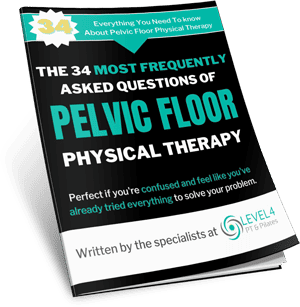
Ever wonder how Pilates can help with your pelvic floor? In this blog, we will give you 5 Pilates exercises that can help with your pelvic floor.
Pilates is a form of exercise that focuses on improved posture, balance, strength and flexibility. It was developed in the early 20th century by Joseph Pilates, who believed that physical and mental wellbeing are interconnected.
Pilates is based on six key principles – concentration, control, centering, precision, breath and flow – which combine to create a holistic workout.
From increasing core stability to improving coordination and circulation, there are many benefits associated with Pilates. Regular practice can help to improve posture and reduce tension in the body while strengthening both your mind and body. As well as helping you become more aware of your own body movements and muscles at work, it can also help boost energy levels and enhance your overall wellbeing.
Pilates is a great way to keep your body active and healthy. By targeting specific muscles and stretches, it can help improve flexibility and range of motion while also strengthening the core.
It is low-impact, making it suitable for all fitness levels, and the emphasis on concentration makes it both meditative and calming. These factors make Pilates particularly beneficial for those with chronic illnesses or injuries who need an exercise that won’t aggravate their condition.
It offers a unique form of exercise that combines elements of traditional strength training with balance work to create a balanced workout regimen tailored to you. With regular practice, you will soon start feeling the benefits as your posture improves, energy levels increase, and overall wellbeing is enhanced.
How Pilates Can Help With Your Pelvic Floor?
Pelvic floor pain or issues are a common concern amongst women of all ages. These conditions can be caused by pregnancy, childbirth, aging, obesity, heavy lifting or repetitive strain on the pelvic muscles. Symptoms include difficulty with urination and bowel movements, sexual dysfunction and pelvic organ prolapse.
Exercise is an important component of treatment for pelvic floor dysfunction because it helps strengthen the underlying muscles and improve abdominal muscle tone. Exercise can also help reduce inflammation in the area and improve posture which can decrease symptoms associated with pelvic floor pain or disorders.
Pilates is a form of exercise that can help with pain, improve general health and wellbeing, and even assist with pelvic floor issues. It emphasizes proper breathing, body alignment, core strength, flexibility and coordination. Its exercises are designed to be low impact which makes it suitable for people of all ages and fitness levels.
The main benefit of Pilates is its ability to reduce pain and tension in muscles and joints due to poor posture or muscular imbalance. Practicing the exercises regularly can help strengthen the back muscles so they don’t become overstretched when standing or sitting for long periods. Stretching helps increase range of motion in joints and also decreases inflammation so pain can be reduced significantly. Working on strengthening and stabilizing core muscles can help reduce lower back pain as well.
Pilates is also great for staying active and improving overall health. It’s a low impact form of exercise that doesn’t put too much strain on the body while still providing a workout. Regular Pilates classes or workouts can help to improve cardiovascular health, increase energy levels, and boost metabolism. It aids in weight loss by targeting areas with excess fat, improving muscle tone and coordination, and promoting better posture.
Pelvic floor problems are common among women but can be managed through pelvic floor exercises such as those found in Pilates routines. During Pilates, we will focus on a series of gentle abdominal contractions that engage the muscles in the abdomen, including those of the pelvic floor.
These exercises involve flexing and releasing the lower abdominal muscles while concentrating on drawing up the pelvic floor muscles at the same time. By focusing on contracting these essential core muscles during each exercise, you will be able to build strength over time and benefit from improved stability and support for your internal organs.
When you are able to strengthen the pelvic floor muscles, it can prevent incontinence, improve sexual functioning and even decrease the risk of prolapse. Pilates focuses on posture, alignment and core strength which can provide added support to the pelvic floor muscles and make them stronger in the long run.
Overall, Pilates is a great form of exercise for overall health and wellbeing. It can help reduce pain, improve flexibility, enhance coordination and balance, strengthen core muscles as well as the pelvic floor muscles, and even assist with weight loss. With regular practice, it can improve general physical condition and even provide relief from certain conditions such as pelvic floor issues.
Pilates Exercises That Help With Pelvic Floor
1. Pelvic Tilts: This Pilates exercise strengthens the pelvic floor muscles, helps to improve posture, and can be especially beneficial for those who suffer from pelvic issues. To perform a pelvic tilt, start by lying flat on your back with your feet planted on the ground and knees bent. Lift your hips off the ground while exhaling slowly and hold this position for five seconds before slowly returning to the starting position. Do 10 repetitions of this move 3 times a week to prevent and/or reduce pelvic pain.
2. Bridge Pose: This Pilates pose stretches and strengthens the lower abdominal muscles as well as strengthening your core and gluteus muscles which will help alleviate discomfort in your pelvis. To do this exercise, begin by lying flat on your back with your feet planted firmly on the ground and your knees bent. As you inhale, lift your hips off the ground while pressing down into your feet, using your glutes to support yourself. Hold this position for five seconds before slowly releasing and returning to the starting position. Do 10 repetitions of this move 3 times a week for best results.
3. Pelvic Rolls: This Pilates exercise strengthens and stretches both the abdominal muscles as well as the pelvic floor muscles which can help alleviate pelvic pain. To do this exercise, start by lying on your back with your knees bent and feet planted firmly on the ground. Next inhale deeply as you roll up one vertebra at a time until you have reached a bridge position. Then exhale as you slowly roll back down to the starting position, until your spine is resting against the ground. Do 10 repetitions of this move 3 times a week for best results.
4. Cat/Cow: This Pilates exercise helps to strengthen and stretch the muscles in the abdominal area while also helping to relieve tension in the pelvis which can cause pain or discomfort. To do this pose, start by getting onto all fours with your hands directly beneath your shoulders and your knees directly beneath your hips. As you inhale deeply, arch your spine up towards the sky while pushing into the floor with both your hands and feet. Hold this pose for five seconds before releasing as you exhale and lowering your spine down towards the ground. Do 10 repetitions of this move 3 times a week for best results.
5. Single Leg Stretch: This Pilates exercise helps to strengthen and stretch the lower abdominal muscles while also providing relief to hips, pelvis, and low back pain. To do this pose, start by lying flat on your back with one leg bent at 90 degrees with your foot planted firmly on the floor and the other straight up towards the sky. As you inhale deeply, hug in your stomach and switch legs so that the other is now straight up towards the sky with your foot planted firmly on the ground. Hold this position for five seconds before slowly switching sides again as you exhale and returning to the starting position. Do 10 repetitions of this move 3 times a week for best results.
Want To Know How Pilates Can Help You?
Have you always been interested in trying Pilates, but you just don’t know where to start? We can help you!
Schedule a Free Pilates “Taster” Session with us at LEVEL4 PT& Pilates to see if Pilates and our studio are right for you!
We are able to offer a Free Pilates Taster Session which is perfect for people suffering with limited strength and flexibility,who could enjoy life much more without these restrictions.
You’ll leave your “Taster” session experiencing Pilates exercises with one of our experienced Certified Instructors. This is a great way to see our studio, experience our teaching and equipment, as you are trying to find the right studio for your needs.
You can also feel free to give us a call at 760-503-4440 (We still like to talk on the phone!)
If you want more information on this free session and Pilates, you can contact us or visit us at LEVEL4 PT & Pilates. Also, download our free guide to help you decide if Pilates and LEVEL4 PT & Pilates is right for you!
We love to keep people in the San Diego area mobile, active, and off pain pills – let our expertise go to work for you to help you return to the activities you love.
Don’t forget, you can schedule a no-obligation (and free!) phone consult or visit us at our Encinitas clinic as part of your Free Pilates “Taster” Session. Or just give us a call at 760-503-4440.
Until next time,
Dr. Dawn Andalon
Other Free Resources from LEVEL4 PT & Pilates…
Download Our Free Guide On Pilates and Choosing The Best Studio – The Best Pilates Studio For You
Read Our Blog – 6 Health Benefits of Pilates
Read Our Blog – Pilates: Is it Good for People with Lower Back Pain or Sciatica?
Follow Us On Social Media – Facebook, Instagram, and YouTube
- The Link Between Menopause and Back Pain - May 21, 2024
- 3 Proven Ways You Can Relieve Sciatic Pain While Sleeping - September 14, 2023
- Menopause and the Impact It Can Have On Your Weight - August 4, 2023


















